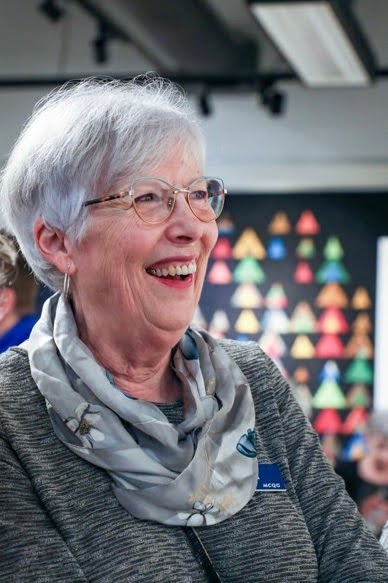Department of Physical Therapy student-turned-professor shares memories of time with the program
23 August 2024
 Joan Loomis did not hesitate to pursue a career in physical therapy after she received a tour of the University of Alberta Hospital’s physical therapy clinic from her family’s neighbour when she was a young woman.
Joan Loomis did not hesitate to pursue a career in physical therapy after she received a tour of the University of Alberta Hospital’s physical therapy clinic from her family’s neighbour when she was a young woman.
“That was it,” she says. “I realized that was something that would suit me.”
What followed was a 30-year career in the Faculty of Rehabilitation Medicine’s Department of Physical Therapy — first as a student, then a teaching faculty and finally as associate chair of the department until her retirement in 2008.
During her time with the program, the clinical professor emeritus witnessed many changes, including classes doubling in size from 40 to 80, an increase in the number of male students from almost zero to about 40 per cent of the class, the implementation of evidence-based practice, the adoption of client-centred care by the wider health-care community, the regulation of the physical therapy profession and the program’s transition from a three-year diploma to a four-year baccalaureate and eventually to a master’s degree.
Throughout her time with the physical therapy program, Loomis continued teaching and her dedication to student success shaped the program of today.
From student to teacher
Loomis graduated from the U of A with a three-year physical therapy diploma in 1969. After working for a year, she returned to complete the four-year baccalaureate program, becoming a member of its first graduating class.
After graduating, Loomis worked at the Glenrose Rehabilitation Hospital where she specialized in neurological physical therapy. She began supervising students and within a year, she was offered the clinical coordinator position there.
From the beginning, Loomis found the students to be very bright and the teaching environment positive. “Physical therapy had small class sizes so we all got to know the students really well, and they got to know us,” she says. “It was more of an atmosphere of mutual respect between the students and the instructors. It was really a culture of mentorship more than a teaching relationship.”
Every year, as mid-term exams approached, Loomis gave her classes a pep talk about research on the learning and confidence curve when learning languages. Knowing the shift in learning from musculoskeletal to neurological physical therapy could be challenging, and the students may have lost the confidence they had gained, she did her best to prepare them.
“They had very different learning to do, and the confidence they had at the beginning of the term was no longer there by the middle of the term, so they really needed to understand the learning and confidence curve,” she explains. “Talking to them about that research on learning seemed to help them overcome their mid-term jitters.”
Her dedication to student success resulted in Loomis receiving a Rutherford Award for Excellence in Undergraduate Teaching in 1990 and a 3M Teaching Fellowship in 2001.
Light-bulb moments
Loomis admits that while teaching had its challenges, it was also rewarding.
“Seeing that light bulb come on was pretty special. You could just tell when they were starting to get it. It was amazing,” she says.
For Loomis, being with students in the clinical skills labs was the best part of the job. The practice exams, where students were tested on their clinical skills, are particularly memorable for her. She found that the standardized patient program improved the exam process. In addition to testing the students’ skills, she could observe their interactions with patients.
“You could see empathy. It was a pleasure to observe the students and see how they would probably interact with clients in the clinical setting.”
In the 1990s, when health professions adopted team-based care, Loomis was highly involved in creating the Interprofessional Health Team Development 410 (Int D 410) course, which serves as a foundation for the interprofessional courses currently offered in the College of Health Sciences.
She remembers one class working on a challenging ethical case. Because it wasn't a clinical case, no discipline had an advantage. The students had to work really hard, struggling to reach a consensus. One evening they were so drawn to the case, that they didn't leave once the class was over.
“They wanted to stay and finish,” Loomis recalls. “Many of them stayed 20 to 30 minutes after class even if they had reached an agreement. They wanted to sit with each other and enjoy their accomplishment.”
Developing the course earned Loomis and her course development colleagues an Alan Blizzard Award from the Society for Teaching and Learning Teaching in Higher Education in 2000.
A team effort
Loomis is quick to credit her clinical colleagues, with whom she stayed in touch after starting at the U of A, for their contributions to the program.
“They were such a huge help during the teaching years. They took my students on tours of clinical settings. If anybody should be acknowledged it should be those clinicians who took the students for special demonstrations,” she says.
Although retired, Loomis hasn’t stopped teaching. Today, she teaches quilting classes as a member of the Mountain Cabin Quilters Guild in Canmore, Alberta.
“I am still connected with teaching. It's awesome. I was acknowledged for teaching in the Department of Physical Therapy, but teaching was more than a job for me. It was really a passion.”